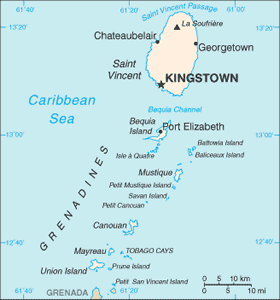The Geography of Saint Vincent and the Grenadines
The Geography of Saint Vincent and the Grenadines
Saint Vincentian or Vincentian Geography
Location: Caribbean, islands between the Caribbean Sea and North Atlantic Ocean, north of Trinidad and Tobago
Geographic coordinates: 13 15 N, 61 12 W
Map references: Central America and the Caribbean
Area: total: 389 sq km (Saint Vincent 344 sq km) land: 389 sq km water: 0 sq km
Area - comparative: twice the size of Washington, DC
Land boundaries: 0 km
Coastline: 84 km
Maritime claims: territorial sea: 12 nm contiguous zone: 24 nm exclusive economic zone: 200 nm continental shelf: 200 nm
Climate: tropical; little seasonal temperature variation; rainy season (May to November)
Terrain: volcanic, mountainous
Elevation extremes: lowest point: Caribbean Sea 0 m highest point: La Soufriere 1,234 m
Natural resources: hydropower, cropland
Land use: arable land: 17.95% permanent crops: 17.95% other: 64.1% (2005)
Irrigated land: 10 sq km (2003)
Natural hazards: hurricanes; Soufriere volcano on the island of Saint Vincent is a constant threat
Environment - current issues: pollution of coastal waters and shorelines from discharges by pleasure yachts and other effluents; in some areas, pollution is severe enough to make swimming prohibitive
Environment - international agreements: party to: Biodiversity, Climate Change, Climate Change-Kyoto Protocol, Desertification, Endangered Species, Environmental Modification, Hazardous Wastes, Law of the Sea, Marine Dumping, Ozone Layer Protection, Ship Pollution, Whaling signed, but not ratified: none of the selected agreements
Geography - note: the administration of the islands of the Grenadines group is divided between Saint Vincent and the Grenadines and Grenada; Saint Vincent and the Grenadines is comprised of 32 islands and cays


